Woolworth Company: Challenges in Organizational Change Management
VerifiedAdded on 2021/05/31
|10
|2507
|66
Report
AI Summary
This report provides an analysis of the organizational change initiatives undertaken by Woolworth Company, a major Australian retailer. The research focuses on the challenges the company faces in implementing corporate social responsibility (CSR) strategies as a marketing tool, including issues related to leadership, communication, and employee engagement. The report explores the desired post-change situation, advocating for democratic leadership, enhanced CSR participation, and improved communication channels. It identifies problems such as poor leadership, lack of teamwork, and the impact of e-commerce. The findings highlight the importance of effective leadership and management in driving CSR initiatives. The report recommends a phased approach to change implementation, based on Lewin's three-step model: unfreezing, moving, and refreezing. It emphasizes the need for clear communication, employee involvement, and the establishment of a supportive organizational culture to ensure the success of the change process and maintain a competitive advantage. The report concludes with recommendations for sustaining the change through ongoing measurement, leadership support, and training.
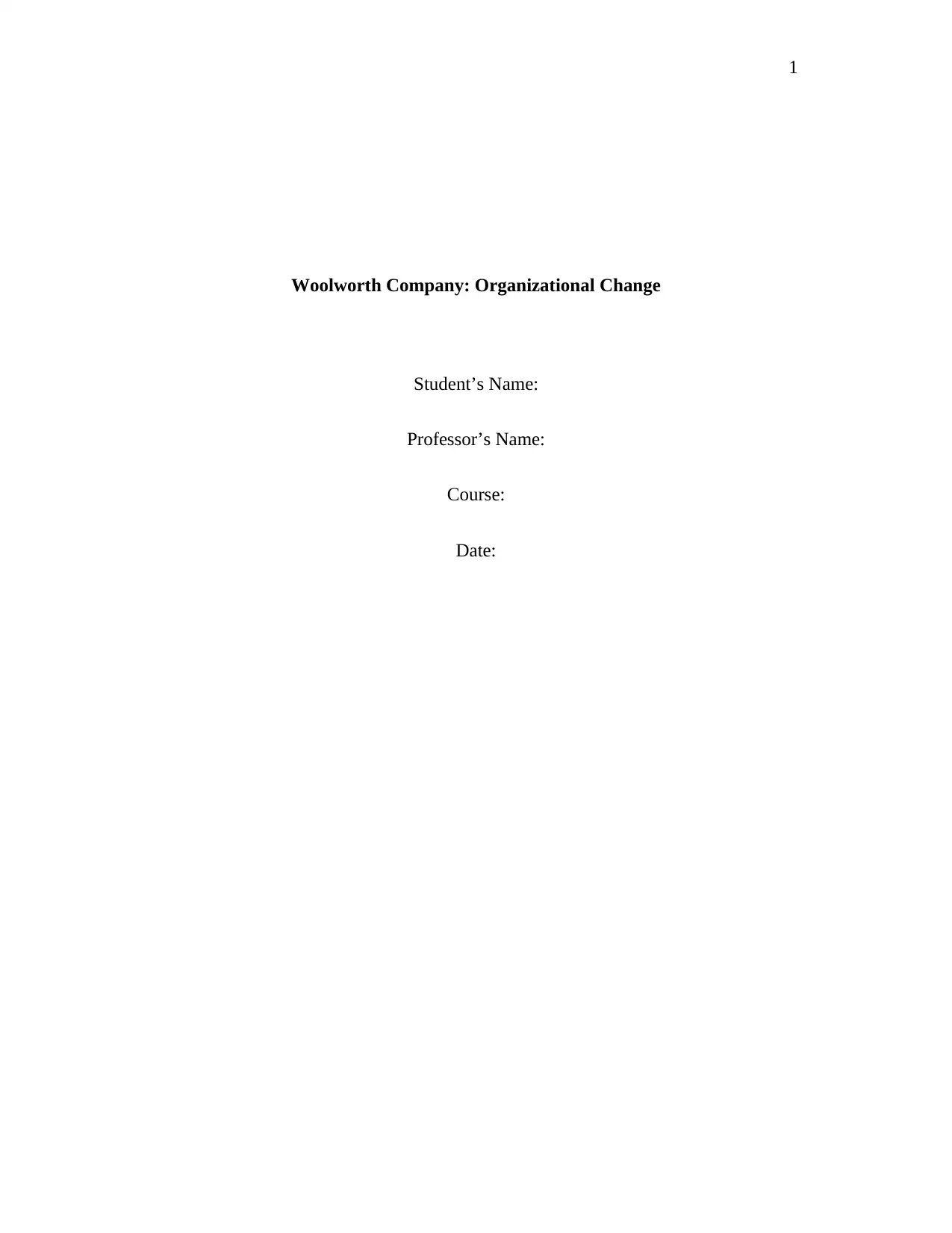
1
Woolworth Company: Organizational Change
Student’s Name:
Professor’s Name:
Course:
Date:
Woolworth Company: Organizational Change
Student’s Name:
Professor’s Name:
Course:
Date:
Paraphrase This Document
Need a fresh take? Get an instant paraphrase of this document with our AI Paraphraser
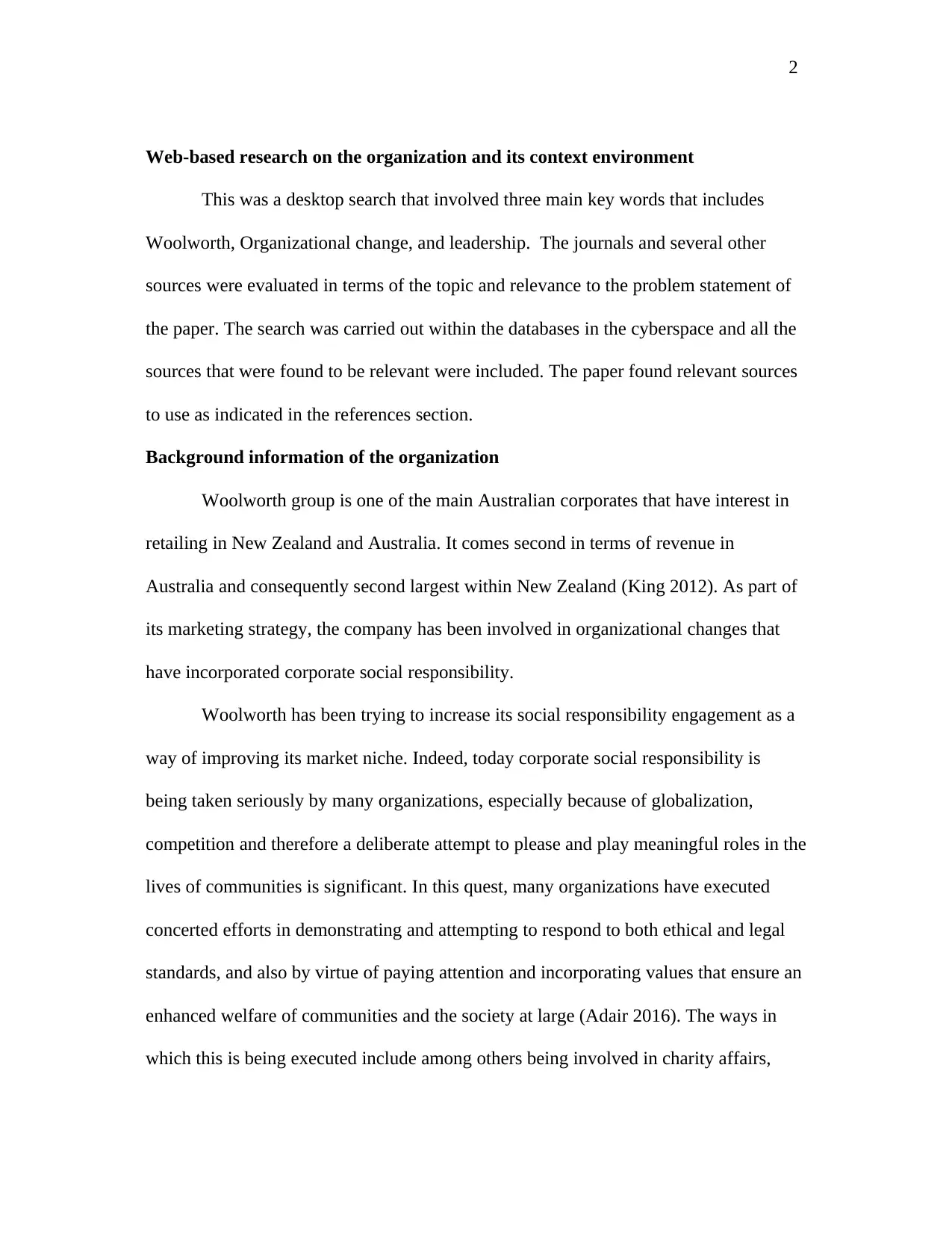
2
Web-based research on the organization and its context environment
This was a desktop search that involved three main key words that includes
Woolworth, Organizational change, and leadership. The journals and several other
sources were evaluated in terms of the topic and relevance to the problem statement of
the paper. The search was carried out within the databases in the cyberspace and all the
sources that were found to be relevant were included. The paper found relevant sources
to use as indicated in the references section.
Background information of the organization
Woolworth group is one of the main Australian corporates that have interest in
retailing in New Zealand and Australia. It comes second in terms of revenue in
Australia and consequently second largest within New Zealand (King 2012). As part of
its marketing strategy, the company has been involved in organizational changes that
have incorporated corporate social responsibility.
Woolworth has been trying to increase its social responsibility engagement as a
way of improving its market niche. Indeed, today corporate social responsibility is
being taken seriously by many organizations, especially because of globalization,
competition and therefore a deliberate attempt to please and play meaningful roles in the
lives of communities is significant. In this quest, many organizations have executed
concerted efforts in demonstrating and attempting to respond to both ethical and legal
standards, and also by virtue of paying attention and incorporating values that ensure an
enhanced welfare of communities and the society at large (Adair 2016). The ways in
which this is being executed include among others being involved in charity affairs,
Web-based research on the organization and its context environment
This was a desktop search that involved three main key words that includes
Woolworth, Organizational change, and leadership. The journals and several other
sources were evaluated in terms of the topic and relevance to the problem statement of
the paper. The search was carried out within the databases in the cyberspace and all the
sources that were found to be relevant were included. The paper found relevant sources
to use as indicated in the references section.
Background information of the organization
Woolworth group is one of the main Australian corporates that have interest in
retailing in New Zealand and Australia. It comes second in terms of revenue in
Australia and consequently second largest within New Zealand (King 2012). As part of
its marketing strategy, the company has been involved in organizational changes that
have incorporated corporate social responsibility.
Woolworth has been trying to increase its social responsibility engagement as a
way of improving its market niche. Indeed, today corporate social responsibility is
being taken seriously by many organizations, especially because of globalization,
competition and therefore a deliberate attempt to please and play meaningful roles in the
lives of communities is significant. In this quest, many organizations have executed
concerted efforts in demonstrating and attempting to respond to both ethical and legal
standards, and also by virtue of paying attention and incorporating values that ensure an
enhanced welfare of communities and the society at large (Adair 2016). The ways in
which this is being executed include among others being involved in charity affairs,
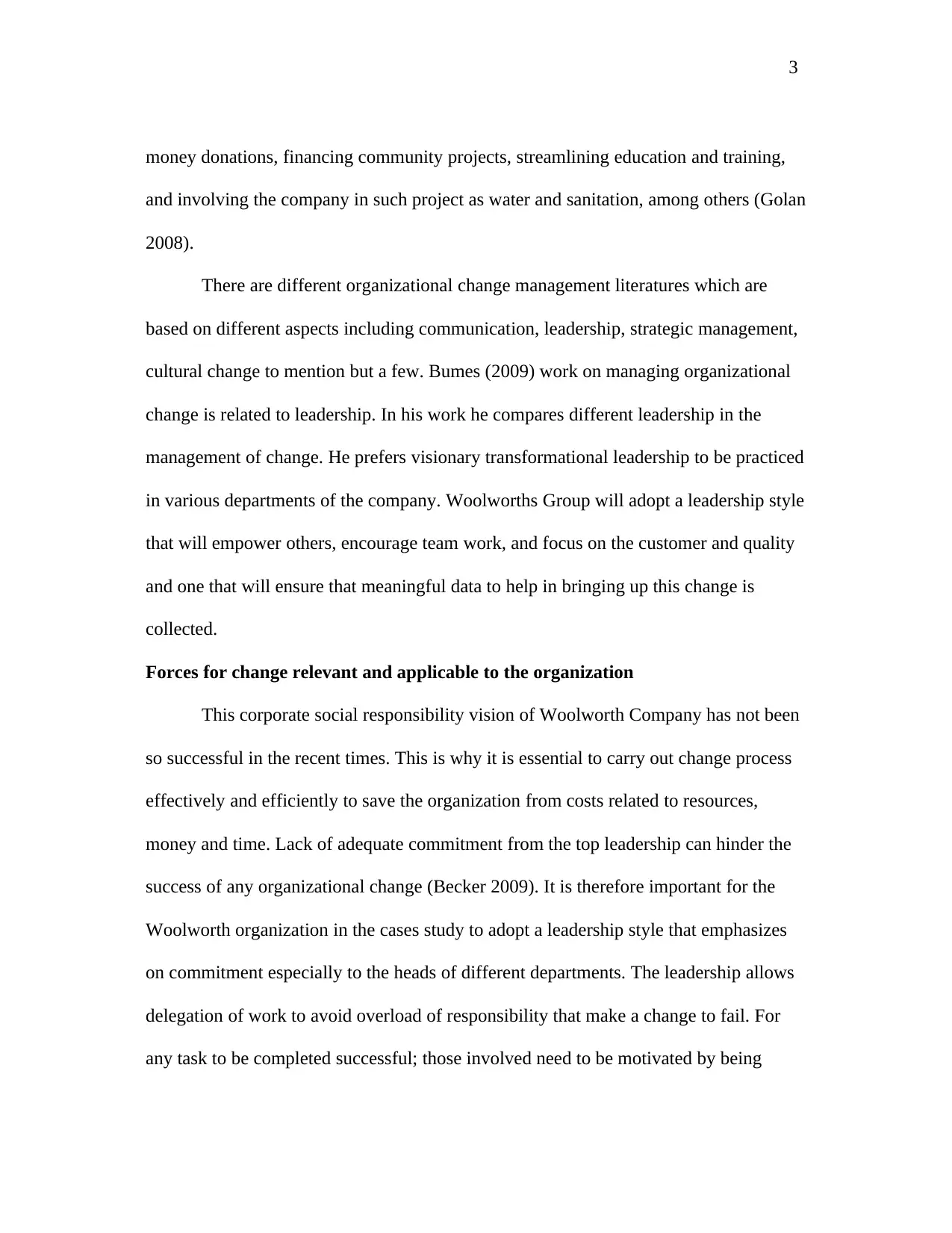
3
money donations, financing community projects, streamlining education and training,
and involving the company in such project as water and sanitation, among others (Golan
2008).
There are different organizational change management literatures which are
based on different aspects including communication, leadership, strategic management,
cultural change to mention but a few. Bumes (2009) work on managing organizational
change is related to leadership. In his work he compares different leadership in the
management of change. He prefers visionary transformational leadership to be practiced
in various departments of the company. Woolworths Group will adopt a leadership style
that will empower others, encourage team work, and focus on the customer and quality
and one that will ensure that meaningful data to help in bringing up this change is
collected.
Forces for change relevant and applicable to the organization
This corporate social responsibility vision of Woolworth Company has not been
so successful in the recent times. This is why it is essential to carry out change process
effectively and efficiently to save the organization from costs related to resources,
money and time. Lack of adequate commitment from the top leadership can hinder the
success of any organizational change (Becker 2009). It is therefore important for the
Woolworth organization in the cases study to adopt a leadership style that emphasizes
on commitment especially to the heads of different departments. The leadership allows
delegation of work to avoid overload of responsibility that make a change to fail. For
any task to be completed successful; those involved need to be motivated by being
money donations, financing community projects, streamlining education and training,
and involving the company in such project as water and sanitation, among others (Golan
2008).
There are different organizational change management literatures which are
based on different aspects including communication, leadership, strategic management,
cultural change to mention but a few. Bumes (2009) work on managing organizational
change is related to leadership. In his work he compares different leadership in the
management of change. He prefers visionary transformational leadership to be practiced
in various departments of the company. Woolworths Group will adopt a leadership style
that will empower others, encourage team work, and focus on the customer and quality
and one that will ensure that meaningful data to help in bringing up this change is
collected.
Forces for change relevant and applicable to the organization
This corporate social responsibility vision of Woolworth Company has not been
so successful in the recent times. This is why it is essential to carry out change process
effectively and efficiently to save the organization from costs related to resources,
money and time. Lack of adequate commitment from the top leadership can hinder the
success of any organizational change (Becker 2009). It is therefore important for the
Woolworth organization in the cases study to adopt a leadership style that emphasizes
on commitment especially to the heads of different departments. The leadership allows
delegation of work to avoid overload of responsibility that make a change to fail. For
any task to be completed successful; those involved need to be motivated by being
⊘ This is a preview!⊘
Do you want full access?
Subscribe today to unlock all pages.

Trusted by 1+ million students worldwide
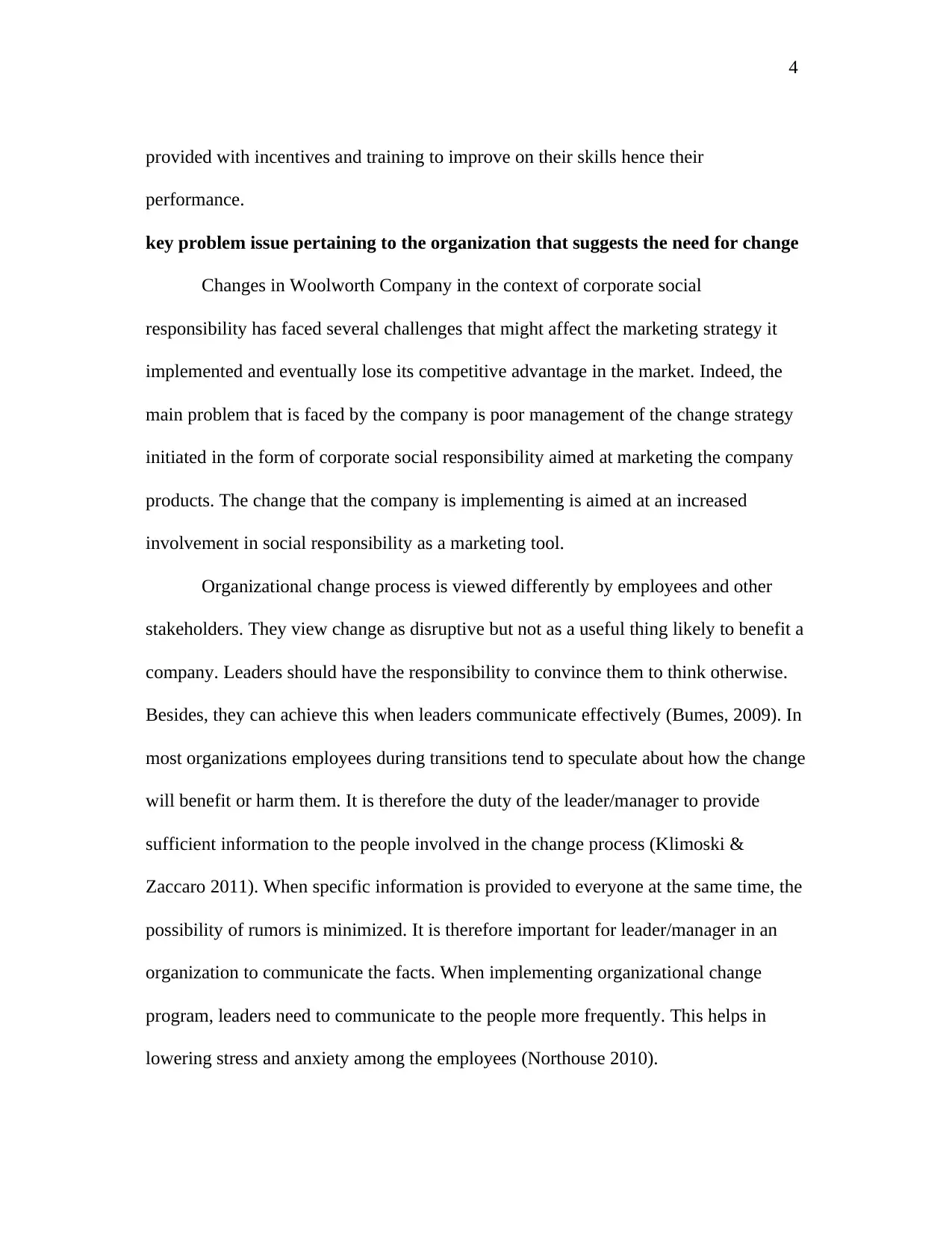
4
provided with incentives and training to improve on their skills hence their
performance.
key problem issue pertaining to the organization that suggests the need for change
Changes in Woolworth Company in the context of corporate social
responsibility has faced several challenges that might affect the marketing strategy it
implemented and eventually lose its competitive advantage in the market. Indeed, the
main problem that is faced by the company is poor management of the change strategy
initiated in the form of corporate social responsibility aimed at marketing the company
products. The change that the company is implementing is aimed at an increased
involvement in social responsibility as a marketing tool.
Organizational change process is viewed differently by employees and other
stakeholders. They view change as disruptive but not as a useful thing likely to benefit a
company. Leaders should have the responsibility to convince them to think otherwise.
Besides, they can achieve this when leaders communicate effectively (Bumes, 2009). In
most organizations employees during transitions tend to speculate about how the change
will benefit or harm them. It is therefore the duty of the leader/manager to provide
sufficient information to the people involved in the change process (Klimoski &
Zaccaro 2011). When specific information is provided to everyone at the same time, the
possibility of rumors is minimized. It is therefore important for leader/manager in an
organization to communicate the facts. When implementing organizational change
program, leaders need to communicate to the people more frequently. This helps in
lowering stress and anxiety among the employees (Northouse 2010).
provided with incentives and training to improve on their skills hence their
performance.
key problem issue pertaining to the organization that suggests the need for change
Changes in Woolworth Company in the context of corporate social
responsibility has faced several challenges that might affect the marketing strategy it
implemented and eventually lose its competitive advantage in the market. Indeed, the
main problem that is faced by the company is poor management of the change strategy
initiated in the form of corporate social responsibility aimed at marketing the company
products. The change that the company is implementing is aimed at an increased
involvement in social responsibility as a marketing tool.
Organizational change process is viewed differently by employees and other
stakeholders. They view change as disruptive but not as a useful thing likely to benefit a
company. Leaders should have the responsibility to convince them to think otherwise.
Besides, they can achieve this when leaders communicate effectively (Bumes, 2009). In
most organizations employees during transitions tend to speculate about how the change
will benefit or harm them. It is therefore the duty of the leader/manager to provide
sufficient information to the people involved in the change process (Klimoski &
Zaccaro 2011). When specific information is provided to everyone at the same time, the
possibility of rumors is minimized. It is therefore important for leader/manager in an
organization to communicate the facts. When implementing organizational change
program, leaders need to communicate to the people more frequently. This helps in
lowering stress and anxiety among the employees (Northouse 2010).
Paraphrase This Document
Need a fresh take? Get an instant paraphrase of this document with our AI Paraphraser
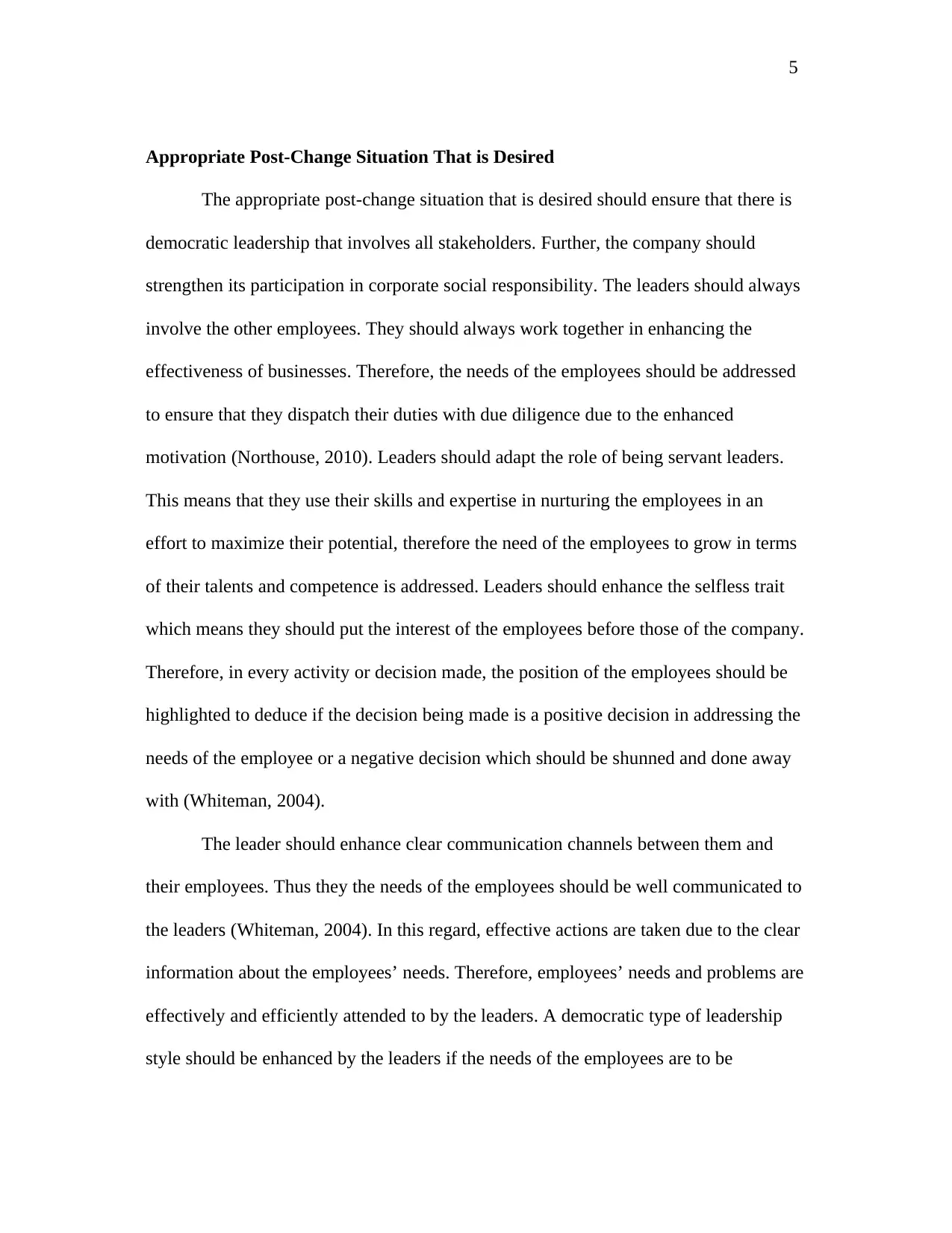
5
Appropriate Post-Change Situation That is Desired
The appropriate post-change situation that is desired should ensure that there is
democratic leadership that involves all stakeholders. Further, the company should
strengthen its participation in corporate social responsibility. The leaders should always
involve the other employees. They should always work together in enhancing the
effectiveness of businesses. Therefore, the needs of the employees should be addressed
to ensure that they dispatch their duties with due diligence due to the enhanced
motivation (Northouse, 2010). Leaders should adapt the role of being servant leaders.
This means that they use their skills and expertise in nurturing the employees in an
effort to maximize their potential, therefore the need of the employees to grow in terms
of their talents and competence is addressed. Leaders should enhance the selfless trait
which means they should put the interest of the employees before those of the company.
Therefore, in every activity or decision made, the position of the employees should be
highlighted to deduce if the decision being made is a positive decision in addressing the
needs of the employee or a negative decision which should be shunned and done away
with (Whiteman, 2004).
The leader should enhance clear communication channels between them and
their employees. Thus they the needs of the employees should be well communicated to
the leaders (Whiteman, 2004). In this regard, effective actions are taken due to the clear
information about the employees’ needs. Therefore, employees’ needs and problems are
effectively and efficiently attended to by the leaders. A democratic type of leadership
style should be enhanced by the leaders if the needs of the employees are to be
Appropriate Post-Change Situation That is Desired
The appropriate post-change situation that is desired should ensure that there is
democratic leadership that involves all stakeholders. Further, the company should
strengthen its participation in corporate social responsibility. The leaders should always
involve the other employees. They should always work together in enhancing the
effectiveness of businesses. Therefore, the needs of the employees should be addressed
to ensure that they dispatch their duties with due diligence due to the enhanced
motivation (Northouse, 2010). Leaders should adapt the role of being servant leaders.
This means that they use their skills and expertise in nurturing the employees in an
effort to maximize their potential, therefore the need of the employees to grow in terms
of their talents and competence is addressed. Leaders should enhance the selfless trait
which means they should put the interest of the employees before those of the company.
Therefore, in every activity or decision made, the position of the employees should be
highlighted to deduce if the decision being made is a positive decision in addressing the
needs of the employee or a negative decision which should be shunned and done away
with (Whiteman, 2004).
The leader should enhance clear communication channels between them and
their employees. Thus they the needs of the employees should be well communicated to
the leaders (Whiteman, 2004). In this regard, effective actions are taken due to the clear
information about the employees’ needs. Therefore, employees’ needs and problems are
effectively and efficiently attended to by the leaders. A democratic type of leadership
style should be enhanced by the leaders if the needs of the employees are to be
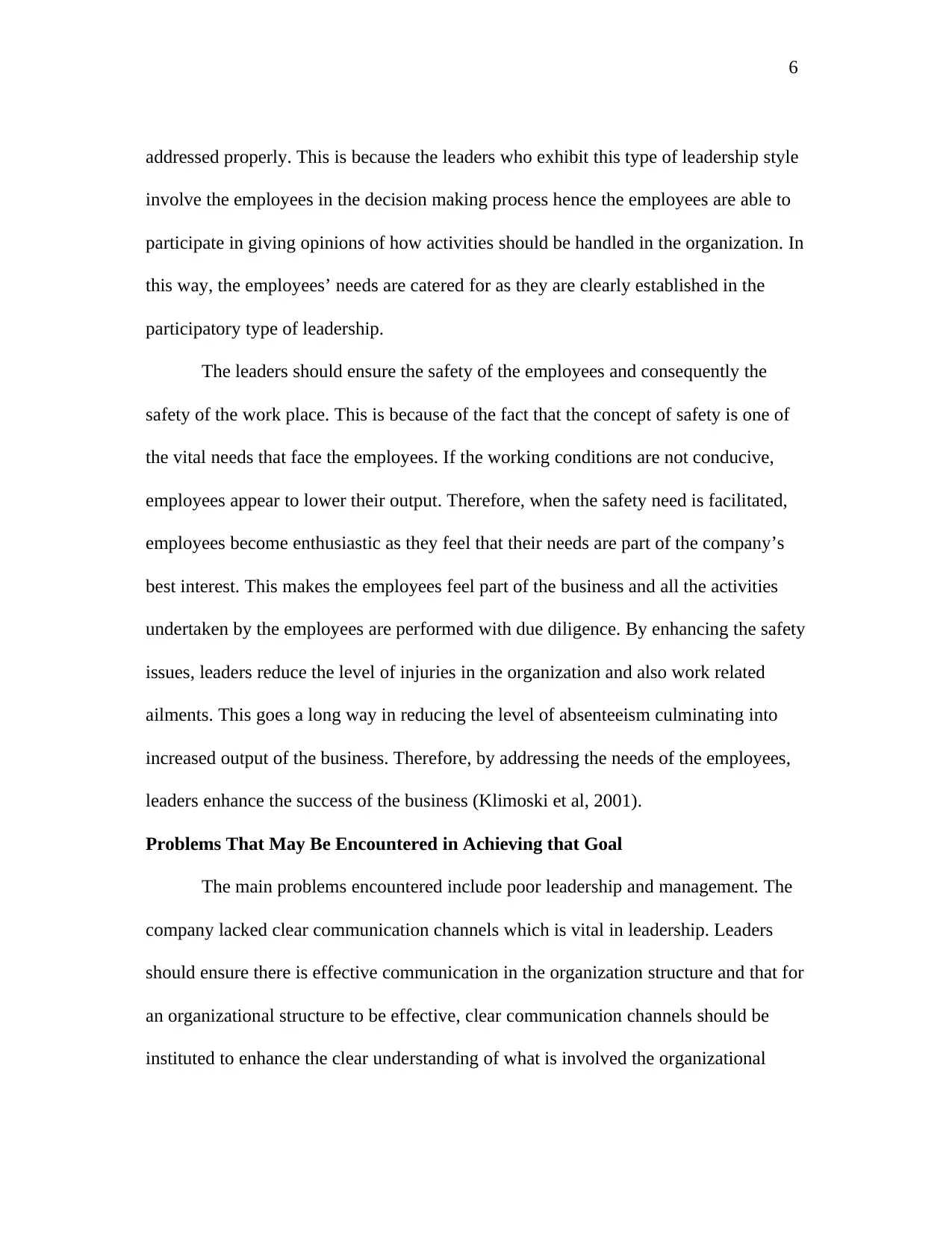
6
addressed properly. This is because the leaders who exhibit this type of leadership style
involve the employees in the decision making process hence the employees are able to
participate in giving opinions of how activities should be handled in the organization. In
this way, the employees’ needs are catered for as they are clearly established in the
participatory type of leadership.
The leaders should ensure the safety of the employees and consequently the
safety of the work place. This is because of the fact that the concept of safety is one of
the vital needs that face the employees. If the working conditions are not conducive,
employees appear to lower their output. Therefore, when the safety need is facilitated,
employees become enthusiastic as they feel that their needs are part of the company’s
best interest. This makes the employees feel part of the business and all the activities
undertaken by the employees are performed with due diligence. By enhancing the safety
issues, leaders reduce the level of injuries in the organization and also work related
ailments. This goes a long way in reducing the level of absenteeism culminating into
increased output of the business. Therefore, by addressing the needs of the employees,
leaders enhance the success of the business (Klimoski et al, 2001).
Problems That May Be Encountered in Achieving that Goal
The main problems encountered include poor leadership and management. The
company lacked clear communication channels which is vital in leadership. Leaders
should ensure there is effective communication in the organization structure and that for
an organizational structure to be effective, clear communication channels should be
instituted to enhance the clear understanding of what is involved the organizational
addressed properly. This is because the leaders who exhibit this type of leadership style
involve the employees in the decision making process hence the employees are able to
participate in giving opinions of how activities should be handled in the organization. In
this way, the employees’ needs are catered for as they are clearly established in the
participatory type of leadership.
The leaders should ensure the safety of the employees and consequently the
safety of the work place. This is because of the fact that the concept of safety is one of
the vital needs that face the employees. If the working conditions are not conducive,
employees appear to lower their output. Therefore, when the safety need is facilitated,
employees become enthusiastic as they feel that their needs are part of the company’s
best interest. This makes the employees feel part of the business and all the activities
undertaken by the employees are performed with due diligence. By enhancing the safety
issues, leaders reduce the level of injuries in the organization and also work related
ailments. This goes a long way in reducing the level of absenteeism culminating into
increased output of the business. Therefore, by addressing the needs of the employees,
leaders enhance the success of the business (Klimoski et al, 2001).
Problems That May Be Encountered in Achieving that Goal
The main problems encountered include poor leadership and management. The
company lacked clear communication channels which is vital in leadership. Leaders
should ensure there is effective communication in the organization structure and that for
an organizational structure to be effective, clear communication channels should be
instituted to enhance the clear understanding of what is involved the organizational
⊘ This is a preview!⊘
Do you want full access?
Subscribe today to unlock all pages.

Trusted by 1+ million students worldwide
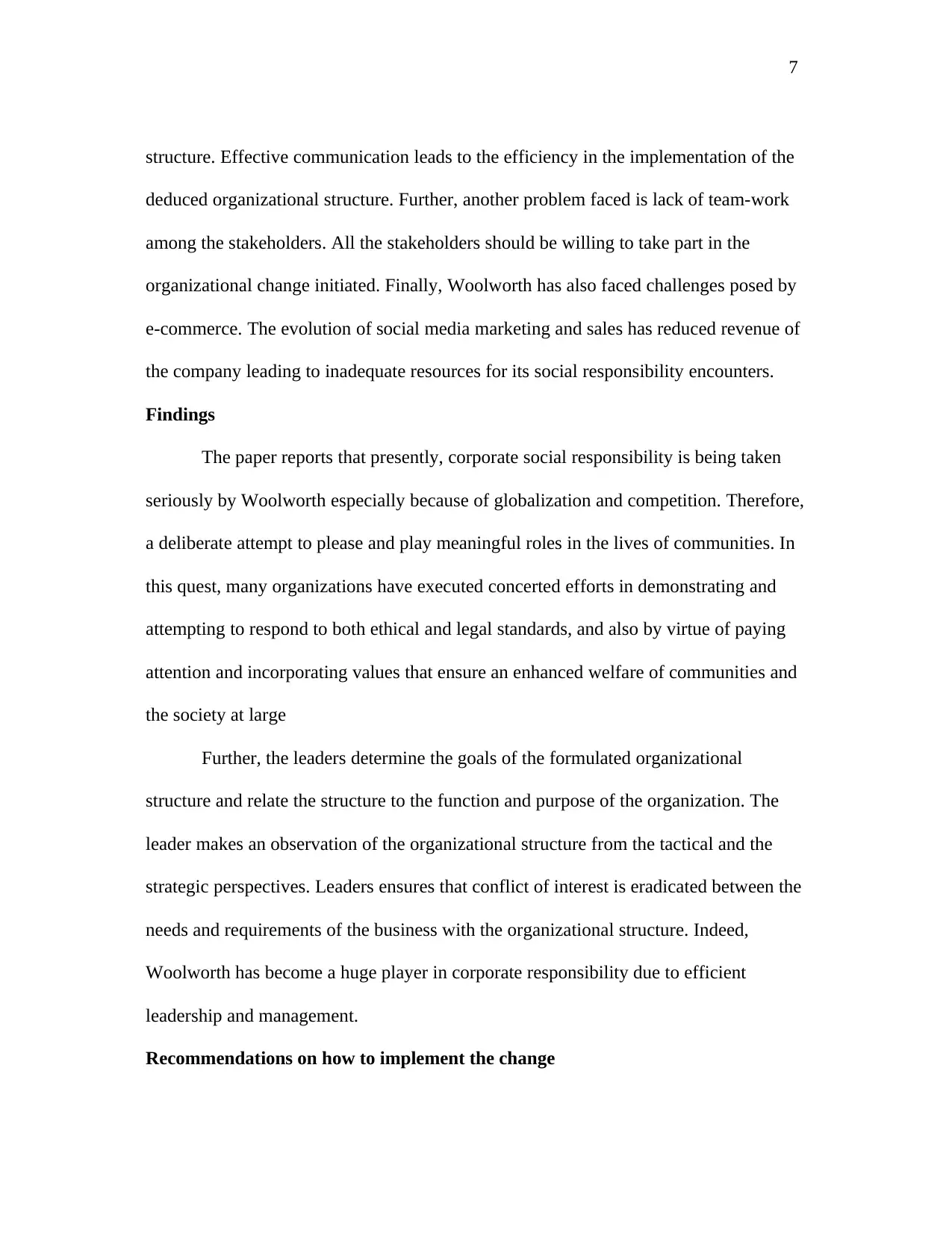
7
structure. Effective communication leads to the efficiency in the implementation of the
deduced organizational structure. Further, another problem faced is lack of team-work
among the stakeholders. All the stakeholders should be willing to take part in the
organizational change initiated. Finally, Woolworth has also faced challenges posed by
e-commerce. The evolution of social media marketing and sales has reduced revenue of
the company leading to inadequate resources for its social responsibility encounters.
Findings
The paper reports that presently, corporate social responsibility is being taken
seriously by Woolworth especially because of globalization and competition. Therefore,
a deliberate attempt to please and play meaningful roles in the lives of communities. In
this quest, many organizations have executed concerted efforts in demonstrating and
attempting to respond to both ethical and legal standards, and also by virtue of paying
attention and incorporating values that ensure an enhanced welfare of communities and
the society at large
Further, the leaders determine the goals of the formulated organizational
structure and relate the structure to the function and purpose of the organization. The
leader makes an observation of the organizational structure from the tactical and the
strategic perspectives. Leaders ensures that conflict of interest is eradicated between the
needs and requirements of the business with the organizational structure. Indeed,
Woolworth has become a huge player in corporate responsibility due to efficient
leadership and management.
Recommendations on how to implement the change
structure. Effective communication leads to the efficiency in the implementation of the
deduced organizational structure. Further, another problem faced is lack of team-work
among the stakeholders. All the stakeholders should be willing to take part in the
organizational change initiated. Finally, Woolworth has also faced challenges posed by
e-commerce. The evolution of social media marketing and sales has reduced revenue of
the company leading to inadequate resources for its social responsibility encounters.
Findings
The paper reports that presently, corporate social responsibility is being taken
seriously by Woolworth especially because of globalization and competition. Therefore,
a deliberate attempt to please and play meaningful roles in the lives of communities. In
this quest, many organizations have executed concerted efforts in demonstrating and
attempting to respond to both ethical and legal standards, and also by virtue of paying
attention and incorporating values that ensure an enhanced welfare of communities and
the society at large
Further, the leaders determine the goals of the formulated organizational
structure and relate the structure to the function and purpose of the organization. The
leader makes an observation of the organizational structure from the tactical and the
strategic perspectives. Leaders ensures that conflict of interest is eradicated between the
needs and requirements of the business with the organizational structure. Indeed,
Woolworth has become a huge player in corporate responsibility due to efficient
leadership and management.
Recommendations on how to implement the change
Paraphrase This Document
Need a fresh take? Get an instant paraphrase of this document with our AI Paraphraser
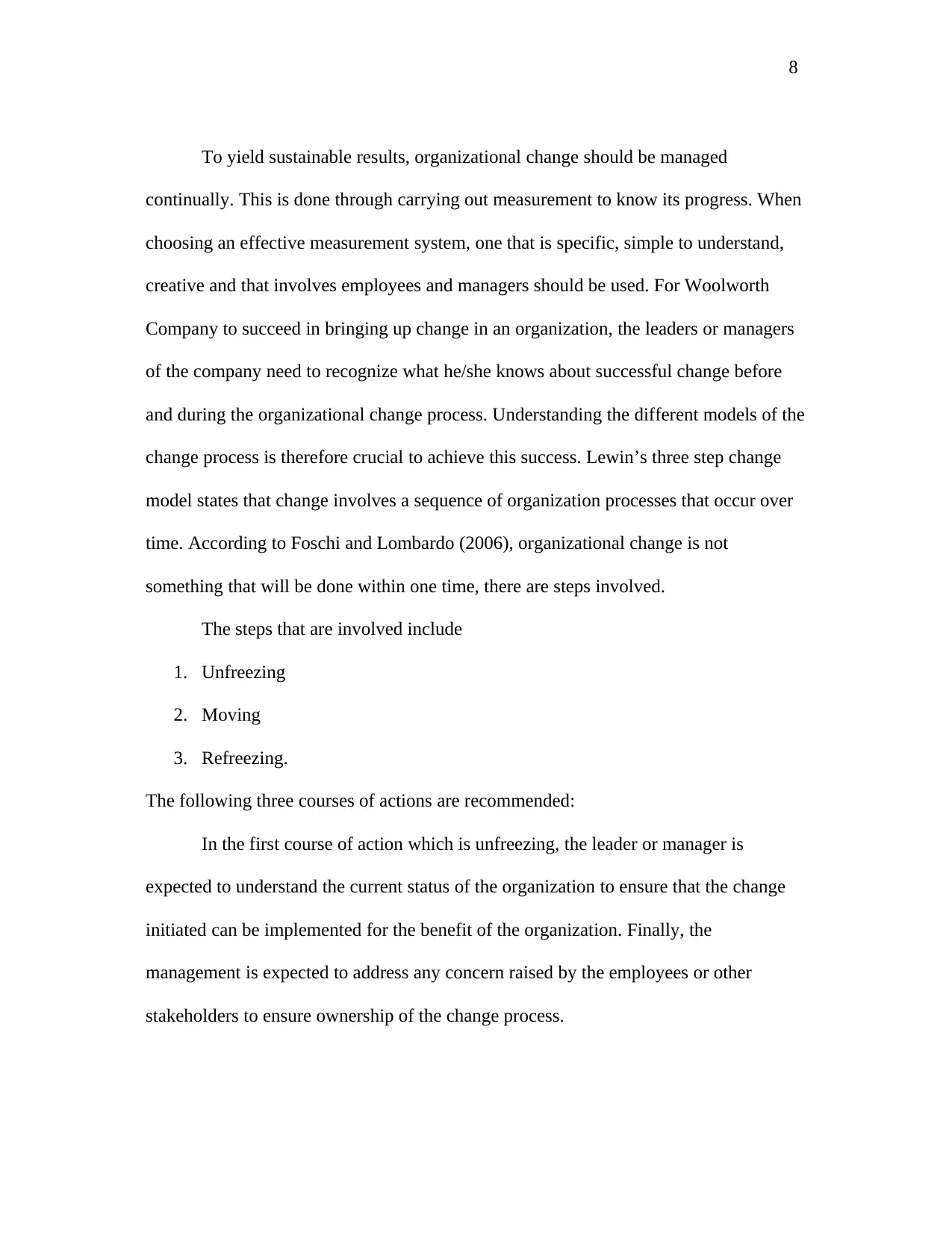
8
To yield sustainable results, organizational change should be managed
continually. This is done through carrying out measurement to know its progress. When
choosing an effective measurement system, one that is specific, simple to understand,
creative and that involves employees and managers should be used. For Woolworth
Company to succeed in bringing up change in an organization, the leaders or managers
of the company need to recognize what he/she knows about successful change before
and during the organizational change process. Understanding the different models of the
change process is therefore crucial to achieve this success. Lewin’s three step change
model states that change involves a sequence of organization processes that occur over
time. According to Foschi and Lombardo (2006), organizational change is not
something that will be done within one time, there are steps involved.
The steps that are involved include
1. Unfreezing
2. Moving
3. Refreezing.
The following three courses of actions are recommended:
In the first course of action which is unfreezing, the leader or manager is
expected to understand the current status of the organization to ensure that the change
initiated can be implemented for the benefit of the organization. Finally, the
management is expected to address any concern raised by the employees or other
stakeholders to ensure ownership of the change process.
To yield sustainable results, organizational change should be managed
continually. This is done through carrying out measurement to know its progress. When
choosing an effective measurement system, one that is specific, simple to understand,
creative and that involves employees and managers should be used. For Woolworth
Company to succeed in bringing up change in an organization, the leaders or managers
of the company need to recognize what he/she knows about successful change before
and during the organizational change process. Understanding the different models of the
change process is therefore crucial to achieve this success. Lewin’s three step change
model states that change involves a sequence of organization processes that occur over
time. According to Foschi and Lombardo (2006), organizational change is not
something that will be done within one time, there are steps involved.
The steps that are involved include
1. Unfreezing
2. Moving
3. Refreezing.
The following three courses of actions are recommended:
In the first course of action which is unfreezing, the leader or manager is
expected to understand the current status of the organization to ensure that the change
initiated can be implemented for the benefit of the organization. Finally, the
management is expected to address any concern raised by the employees or other
stakeholders to ensure ownership of the change process.
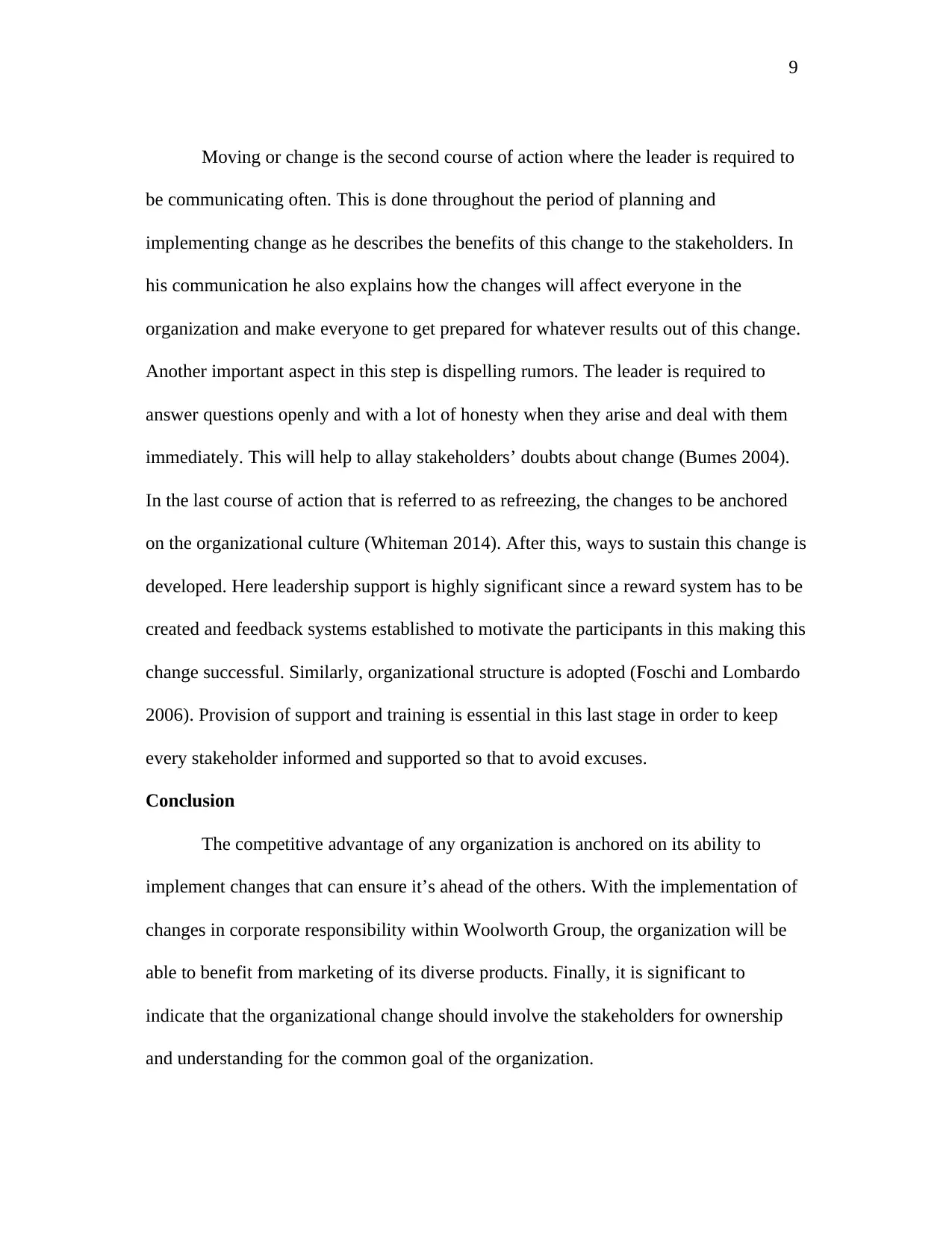
9
Moving or change is the second course of action where the leader is required to
be communicating often. This is done throughout the period of planning and
implementing change as he describes the benefits of this change to the stakeholders. In
his communication he also explains how the changes will affect everyone in the
organization and make everyone to get prepared for whatever results out of this change.
Another important aspect in this step is dispelling rumors. The leader is required to
answer questions openly and with a lot of honesty when they arise and deal with them
immediately. This will help to allay stakeholders’ doubts about change (Bumes 2004).
In the last course of action that is referred to as refreezing, the changes to be anchored
on the organizational culture (Whiteman 2014). After this, ways to sustain this change is
developed. Here leadership support is highly significant since a reward system has to be
created and feedback systems established to motivate the participants in this making this
change successful. Similarly, organizational structure is adopted (Foschi and Lombardo
2006). Provision of support and training is essential in this last stage in order to keep
every stakeholder informed and supported so that to avoid excuses.
Conclusion
The competitive advantage of any organization is anchored on its ability to
implement changes that can ensure it’s ahead of the others. With the implementation of
changes in corporate responsibility within Woolworth Group, the organization will be
able to benefit from marketing of its diverse products. Finally, it is significant to
indicate that the organizational change should involve the stakeholders for ownership
and understanding for the common goal of the organization.
Moving or change is the second course of action where the leader is required to
be communicating often. This is done throughout the period of planning and
implementing change as he describes the benefits of this change to the stakeholders. In
his communication he also explains how the changes will affect everyone in the
organization and make everyone to get prepared for whatever results out of this change.
Another important aspect in this step is dispelling rumors. The leader is required to
answer questions openly and with a lot of honesty when they arise and deal with them
immediately. This will help to allay stakeholders’ doubts about change (Bumes 2004).
In the last course of action that is referred to as refreezing, the changes to be anchored
on the organizational culture (Whiteman 2014). After this, ways to sustain this change is
developed. Here leadership support is highly significant since a reward system has to be
created and feedback systems established to motivate the participants in this making this
change successful. Similarly, organizational structure is adopted (Foschi and Lombardo
2006). Provision of support and training is essential in this last stage in order to keep
every stakeholder informed and supported so that to avoid excuses.
Conclusion
The competitive advantage of any organization is anchored on its ability to
implement changes that can ensure it’s ahead of the others. With the implementation of
changes in corporate responsibility within Woolworth Group, the organization will be
able to benefit from marketing of its diverse products. Finally, it is significant to
indicate that the organizational change should involve the stakeholders for ownership
and understanding for the common goal of the organization.
⊘ This is a preview!⊘
Do you want full access?
Subscribe today to unlock all pages.

Trusted by 1+ million students worldwide
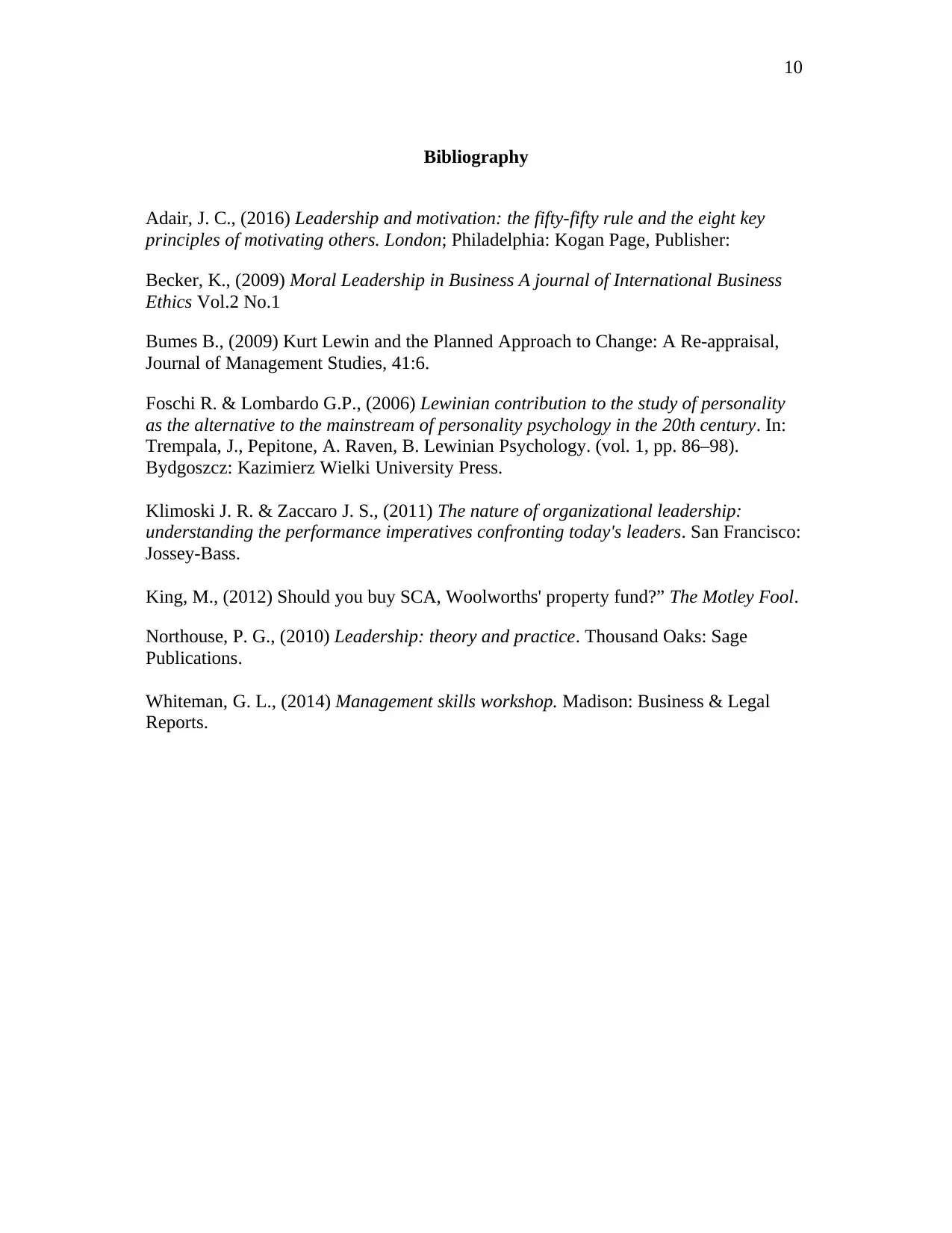
10
Bibliography
Adair, J. C., (2016) Leadership and motivation: the fifty-fifty rule and the eight key
principles of motivating others. London; Philadelphia: Kogan Page, Publisher:
Becker, K., (2009) Moral Leadership in Business A journal of International Business
Ethics Vol.2 No.1
Bumes B., (2009) Kurt Lewin and the Planned Approach to Change: A Re-appraisal,
Journal of Management Studies, 41:6.
Foschi R. & Lombardo G.P., (2006) Lewinian contribution to the study of personality
as the alternative to the mainstream of personality psychology in the 20th century. In:
Trempala, J., Pepitone, A. Raven, B. Lewinian Psychology. (vol. 1, pp. 86–98).
Bydgoszcz: Kazimierz Wielki University Press.
Klimoski J. R. & Zaccaro J. S., (2011) The nature of organizational leadership:
understanding the performance imperatives confronting today's leaders. San Francisco:
Jossey-Bass.
King, M., (2012) Should you buy SCA, Woolworths' property fund?” The Motley Fool.
Northouse, P. G., (2010) Leadership: theory and practice. Thousand Oaks: Sage
Publications.
Whiteman, G. L., (2014) Management skills workshop. Madison: Business & Legal
Reports.
Bibliography
Adair, J. C., (2016) Leadership and motivation: the fifty-fifty rule and the eight key
principles of motivating others. London; Philadelphia: Kogan Page, Publisher:
Becker, K., (2009) Moral Leadership in Business A journal of International Business
Ethics Vol.2 No.1
Bumes B., (2009) Kurt Lewin and the Planned Approach to Change: A Re-appraisal,
Journal of Management Studies, 41:6.
Foschi R. & Lombardo G.P., (2006) Lewinian contribution to the study of personality
as the alternative to the mainstream of personality psychology in the 20th century. In:
Trempala, J., Pepitone, A. Raven, B. Lewinian Psychology. (vol. 1, pp. 86–98).
Bydgoszcz: Kazimierz Wielki University Press.
Klimoski J. R. & Zaccaro J. S., (2011) The nature of organizational leadership:
understanding the performance imperatives confronting today's leaders. San Francisco:
Jossey-Bass.
King, M., (2012) Should you buy SCA, Woolworths' property fund?” The Motley Fool.
Northouse, P. G., (2010) Leadership: theory and practice. Thousand Oaks: Sage
Publications.
Whiteman, G. L., (2014) Management skills workshop. Madison: Business & Legal
Reports.
1 out of 10
Related Documents
Your All-in-One AI-Powered Toolkit for Academic Success.
+13062052269
info@desklib.com
Available 24*7 on WhatsApp / Email
![[object Object]](/_next/static/media/star-bottom.7253800d.svg)
Unlock your academic potential
Copyright © 2020–2025 A2Z Services. All Rights Reserved. Developed and managed by ZUCOL.





